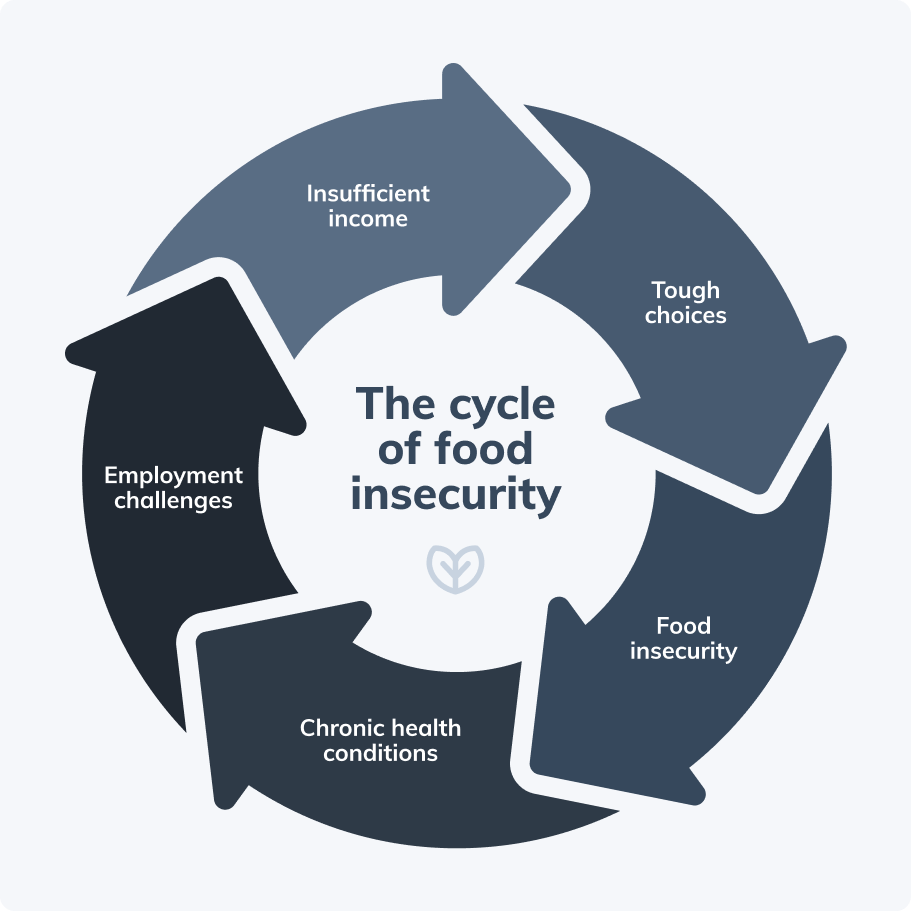Think for a moment about not being able to provide adequate food for your family—food that is nutritious, affordable, and acquired in a safe and dignified manner. For one in eight households in Canada (21) and the United States, (3) food insecurity is their reality. These households are challenged to provide nutritious and balanced meals, or they miss meals completely. Primarily, this is caused by financial constraints. Food insecurity significantly affects health and well-being, impacting physical, mental, and social health. Notably, food insecurity is associated with obesity. (6) In this article, we’ll dive into the impacts of food insecurity and learn about the food insecurity solutions to help the affected families in our communities.

The 5 A’s of food security
What does it take to be a food-secure household? Let’s explore the 5 A’s of food security:
- Availability: There is enough food for all in the family to have all their meals.
- Accessibility: The shelves are stocked and there is enough money to buy food.
- Adequacy: The food available is nutritious, safe to obtain, and environmentally friendly.
- Acceptability: Cultural food preferences are considered, and dignity and self-respect are not compromised.
- Agency: Families are enabled to be food secure through equitable policies and supportive processes. (2)
Did you know? Food deserts increase food insecurity. Food deserts are urban areas in which grocery stores stocking fresh and healthy foods are fewer and far between. Families in these communities resort to purchasing food at convenience stores and fast-food restaurants, paying higher prices for less nutritious food. Former First Lady Michelle Obama took on food deserts in her “Let’s Move” campaign. We too can advocate for better access to food in our communities. (11)
Who is most vulnerable to food insecurity?
Food insecurity is inextricably linked to financial inadequacy—a lack of an adequate and steady income with little to no financial assets. But what other factors increase the risk of being food insecure?
Households with children
Households with children are more vulnerable to food insecurity. Thankfully, over half of these households report being able to provide food for their children. However, the parents and caregivers are often food insecure. (3) Additionally, when households with children are led by single parents the risk increases, with female-led households having the highest risk. (16)
Minority groups
Racial, ethinic, and cultural minorities face an increased risk of food insecurity, particularly Black, Hispanic, and Indigenous households stemming from structural racialization. (7)(21) Structural racialization is defined as a set of practices, cultural norms and institutional arrangements that perpetuate racialized outcomes. (7) This has been shown to lead to inequitable access to education, transportation, housing, employment, and healthcare—factors that are directly responsible for the resultant insufficient incomes and challenges faced in obtaining food. (7)
Individuals with lower income
Finally, low wages and lack of consistent and steady employment is a key factor in food insecurity. Simply being employed is not enough. In fact, the majority of households that report being food insecure are employed. Higher wages, more stability, and better employment conditions significantly improve the ability to be food secure. (13) Families with lower incomes are also more likely to rent versus owning their homes. Various studies have found home ownership to be protective against food insecurity. (8)(21)
What is the impact of food insecurity?
Food insecurity has a tremendous impact on health and our healthcare systems. The consequences of not receiving an adequate and nutritious diet surpass hunger and a lack of nutrients alone, resulting in negative health outcomes and disparities. (17) Read on to discover four important impacts food insecurity has on health.
Diet and nutrition
From a young age, we are told, “you are what you eat.” And it’s true! We are literally built and maintained by the foods and beverages we consume on a daily basis. Nutrients from food provide us with fuel for energy, act as the building blocks we need to have strong bones and muscles, and keep our various organs and systems functioning optimally. Food insecure households are more likely to consume diets that lack nutrition with lower intakes of fruits and vegetables, (15) increased sodium (salt), and decreased protein. (12) This combination of a lack and excess of nutrients contributes to the development of chronic health conditions.
Chronic health conditions
Our physical, mental, and emotional health form the foundation of a good quality of life. Food insecurity threatens this by increasing the risk of a variety of chronic health conditions including heart disease, diabetes, asthma, and arthritis. Management of these health conditions is further challenged by not being able to afford medications and treatments. (19)
Obesity
Paradoxically, obesity and food insecurity are linked. How so you may ask?
We’ve heard a balanced diet is key to achieving and maintaining a healthy weight. Food insecurity is not only defined by an inadequate diet but also an unbalanced, unhealthy diet. Combined with additive factors such as food deserts, the cost of healthy foods, and a lack of time to prepare nutritious meals, food insecure families are more likely to consume “empty calories” (processed foods that are low in nutrients), leading to obesity. (12)(13)
Mental health
It comes as no surprise that food insecurity is associated with a heightened risk of anxiety and depression. (9) The stress of finances, loss of employment, and childcare costs already contributing to mental health challenges are only compounded by the challenges food insecure households face everyday.
The cycle of food insecurity
Being food insecure means needing to make tough choices daily. Bill payments or nutritious food? Housing costs or medications? We can begin to see a cycle emerge, a cycle that is rooted in insufficient income resulting in chronic health conditions. (10) This leads to challenges in acquiring and maintaining adequate employment, further amplifying low incomes. (10)

How can we be part of the solution?
It’s our responsibility and privilege to improve our communities and help our neighbors. And we can help! We can encourage change that breaks the cycle. To do so, we must tackle the root cause, insufficient income, and ensure that workers have a living, stable wage. (18) Here are three ways that we can make a difference.
1. Write to a lawmaker
We’ve seen that policies and programs that support individuals to have an adequate income ensure that they have enough money to support their basic needs. Evidence of this comes from old-age securities and pensions. Seniors are less vulnerable to food insecurity as these income supports are a protection and safety net. This example can be applied across our population to benefit groups that are more vulnerable. (18)
2. Tackle food deserts
We saw how a lack of access to and shortages of affordable, nutritious food leads to food insecurity. Community gardens, farmers’ markets, rezoning to allow for urban agriculture and selling of produce, and better transportation options can greatly increase access to good-quality food. And when we see that new fast-food joint coming to our neighborhoods, let’s push back and advocate for a small grocery store instead. (5)
3. Reduce food waste
In the United States, 30 to 40% of the food supply is wasted. (1) What’s the link between food waste and food insecurity? Essentially, we’re brought back to economics: the cost of food production increases, resulting in higher prices at the stores. (20) By reducing your food waste, eating seasonally, and educating those around you, we can begin to really impact food security and climate change. Although it may help in the short term, diverting food waste to food insecure households doesn’t help to take these families out of the cycle. (4)
The bottom line
The common thread throughout our discussion of food insecurity has been insufficient income. To support those that are most vulnerable, we need to find and implement solutions that tackle the root cause of food insecurity. A lack of wholesome, balanced nutrition poses significant health challenges, those that affect the individual as well as society through increased healthcare costs. Utilizing your voice, your creativity, and your diligence can and will make a huge impact.
- Buzby, J. (2022). Why should we care about food waste? USDA. https://www.usda.gov/foodlossandwaste/why
- Canadian Feed The Children. (2022). The ultimate guide to food security 2021. https://canadianfeedthechildren.ca/the-feed/food-security-guide/
- Coleman-Jensen, A., Rabbitt, M. P., & Gregory, C. A. (2020). Household food security in the United States in 2019. U.S. Department of Agriculture, Economic Research Service. https://www.ers.usda.gov/webdocs/publications/99282/err-275.pdf?v=228.1
- Dachner, N., & Tarasuk, V. (2022). Food waste and food insecurity in Canada. PROOF. https://proof.utoronto.ca/2017/food-waste-and-food-insecurity-in-canada/
- Dailee, A. (2021). 5 solutions that alleviate food insecurity in the U.S. Medium. https://heated.medium.com/5-solutions-that-alleviate-food-insecurity-in-the-u-s-767ba03fcb94
- Dhurandhar, E. J. (2016). The food-insecurity obesity paradox: A resource scarcity hypothesis. Physiology & Behavior, 162, 88–92.
- Elsheikh, E., & Barhoum, N. (2013). Structural racialization and food insecurity in the United States. https://haasinstitute.berkeley.edu/sites/default/files/Structural%20Racialization%20%20%26%20Food%20Insecurity%20in%20the%20US-(Final).pdf
- Fafard St-Germain, A. A., & Tarasuk, V. (2020). Homeownership status and risk of food insecurity: Examining the role of housing debt, housing expenditure and housing asset using a cross-sectional population-based survey of Canadian households. International Journal for Equity in Health, 19(1).
- Fang, D., Thomsen, M. R., & Nayga, R. M. (2021). The association between food insecurity and mental health during the COVID-19 pandemic. BMC Public Health, 21(1).
- Feed Ontario. (2022). Poverty creates a vicious cycle of food insecurity and poor health. https://feedontario.ca/story/poverty-creates-a-vicious-cycle-of-food-insecurity-and-poor-health/
- Haskell, S. (2022). Food insecurity and food deserts: How are they related? Institute for Food Laws and Regulations. https://www.canr.msu.edu/news/food-insecurity-and-food-deserts-how-are-they-related
- Hutchinson, J., & Tarasuk, V. (2021). The relationship between diet quality and the severity of household food insecurity in Canada. Public Health Nutrition, 25(4), 1013–1026.
- Martin, K. S., & Ferris, A. M. (2007). Food insecurity and gender are risk factors for obesity. Journal of Nutrition Education and Behavior, 39(1), 31–36.
- McIntyre, L., Bartoo, A. C., & Emery, J. H. (2012). When working is not enough: Food insecurity in the Canadian labour force. Public Health Nutrition, 17(1), 49–57.
- Mello, J. A., Gans, K. M., Risica, P. M., Kirtania, U., Strolla, L. O., & Fournier, L. (2010). How is food insecurity associated with dietary behaviors? An analysis with low-Income, ethnically diverse participants in a nutrition intervention study. Journal of the American Dietetic Association, 110(12), 1906–1911.
- Miller, D. P., Nepomnyaschy, L., Ibarra, G. L., & Garasky, S. (2014). Family structure and child food insecurity. American Journal of Public Health, 104(7), e70–e76.
- Office of Disease Prevention and Health Promotion. (2022). Food Insecurity. Healthy People 2020. https://www.healthypeople.gov/2020/topics-objectives/topic/social-determinants-health/interventions-resources/food-insecurity
- PROOF. (2022). Video: How to tackle food insecurity in Canada. https://proof.utoronto.ca/resource/how-to-tackle-food-insecurity-in-canada/
- PROOF. (2016). The impact of food insecurity on health. Research to identify policy options to reduce food insecurity (PROOF). https://proof.utoronto.ca/wp-content/uploads/2016/06/health-impact-factsheet.pdf
- Santeramo, F. G. (2021). Exploring the link among food loss, waste and food security: What the research should focus on? Agriculture & Food Security, 10(1).
- Tarasuk, V., & Mitchell, A. (2020). Household food insecurity in Canada, 2017–18. Research to identify policy options to reduce food insecurity (PROOF). https://proof.utoronto.ca/wp-content/uploads/2020/03/Household-Food-Insecurity-in-Canada-2017-2018-Full-Reportpdf.pdf





